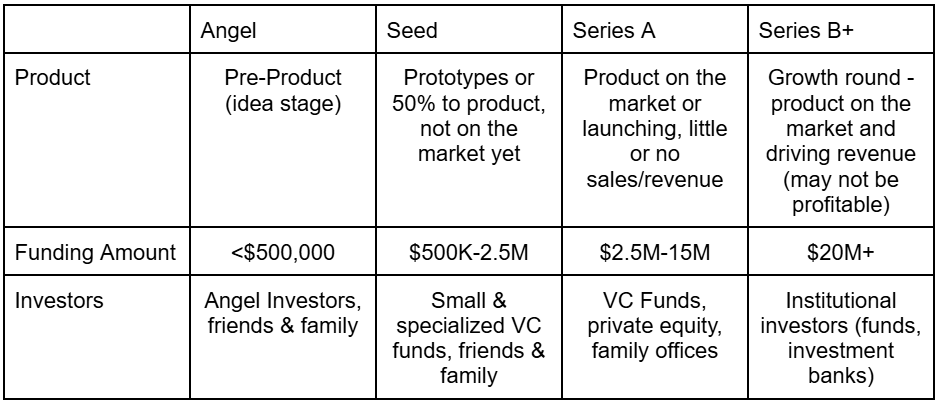When thinking about raising investment capital, one of the first things to establish upfront is what stage of funding your business is at. Let’s check out this table below for a closer look at all different stages of funding (note: some parties might disagree on the exact definitions, but this is the general consensus):
Angel Round: Angel Rounds are the earliest possible stage of financing a company can look to receive. Most angel rounds are less than $500k total (although sometimes up to $1M), and typically are for around 10% of the company. However, the nature of angel investing tends to leave the deals fairly open ended, with a lot of potential structural differences.
Generally, angel investors are a specific classification of investor; meaning you won’t get a VC fund that doesn’t typically do angel deals to “take a chance” on your business. Angel investors are unique, primarily due to the insane amount of risk that accompanies the practice. Those who do it, do it exclusively, and those who don’t, never will.
Finding an angel investor to take a chance on you might be a pretty difficult task, since the investor is basically relying on the founder's word that they’re going to do what they say. If the investor doesn’t know the founders beforehand, this can get tricky. You may have heard of “friends and family rounds” of funding - which basically means exactly what it sounds like. Oftentimes at this early stage of the business, it’s a lot easier to source some initial funding from people who already know you well, versus trying to find an angel to take a leap of faith. After all, if your company has no product or prototypes, and just a business plan, there’s a lot of trust involved in getting an investor to hop on board.
Seed Round: Seed Rounds are the next early-stage funding round after Angel, and slightly more ubiquitous. You may have heard of tech startups raising $100M+ seed rounds with investors like Google or NVIDIA. While this does happen, it’s definitely not the norm. Usually, a seed round will be for somewhere in the $500,000-$2.5M range.
The difference between an Angel round and a Seed round basically comes down to size and where the product sits in its evolution. A company will look to raise a seed round likely when they have some initial prototypes for their product. A founder or team may have already spent 6 months to a year designing and developing, likely with some initial funding from the founders or an angel or friends and family round.
At this point in the process, you may be able to get some funding from venture capital (VC) funds. However, much like angel investors, the VC’s who do seed investing are specialized and not particularly common. Most VC’s won’t like the risk tolerance associated with seed level investing, as it’s largely still a gamble. It’s also not particularly uncommon for other companies to invest in seed rounds for products that might help their business. In the future, this may be an inroad for that company to fully acquire the business, if everything works out.
Series A: Series A fundraising is when things start to get interesting. A normal Series A round will fall somewhere in the $5-20M range, but it’s not unheard of for valuations to go significantly higher at this point. Especially if there’s competing interest, Series A funding is when a company can really cash in and give their product the best possible chance at success.
By the time a Series A round is underway, the company and the product will be basically ready to hit the market, if it hasn’t already. It’s quite common for a company to raise a Series A before they’ve even received a dollar of revenue (which might be surprising giving the investment amounts we’ve mentioned). However the important part is that the Series A will give the company the cash it needs to bring its product to market.
At this point, the company may have spent millions of dollars on research & development, perfecting prototypes, and building out initial teams. Series A funding is meant to provide that final push the company needs to roll out their product, conduct marketing campaigns, and hire the best talent out there to complete their C-Suite.
Series B+ (Growth): Every fundraising round after a Series A is generally considered to be a “growth” round. The size of investments at this stage can be quite staggering, varying from as low as $20-30M up to well into the billions of dollars.
Companies raising growth rounds will already have revenue and potentially profits to show investors, and will have a clear mandate for the use of investment funds they’re looking to raise. They may be looking to expand into new markets, acquire other companies or develop new lines of products.
For the purpose of this course we’re going to focus on the first three stages of capital raising and less so on Series B+, mostly because at that point, a course like this would be superfluous.

